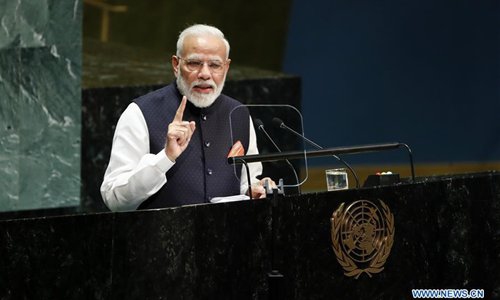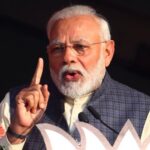Indian Prime Minister Narendra Modi came into power with the slogan of a “neighborhood first” policy. It was well received among policy experts and strategists. It was perceived that India would try to improve its relationship with regional countries. It was also hoped that India would try to solve its outstanding issues like Kashmir and others — namely with its neighbors. PM Modi started the policy by inviting regional leaders to his inauguration. He also visited neighboring countries and presented himself as great advocate of regional connectivity. India tried to use optics in its favor and was portrayed as a great champion of peace and development in region — although its actions went in other direction.
However, experts also wondered: How India will pursue it neighborhood first policy in the presence of “coercive diplomacy?” As it was not fashionable nor in the interests of New Delhi’s Western partners, nobody debated it or tried to decode it. BJP and Indian elites perceived it as an opportunity and started to pursue the agenda of a Greater India. It started to interfere with regional countries under the slogan of “Akhand Bharat.”
First, it picked up war with Pakistan and started to repeat the old propaganda of terrorism. Pakistan tried to respond in a cool manner, but India took it as weakness. India attacked Pakistan in February 2019 and claimed that it had killed many terrorists. However, the reality was different. Pakistan replied next day and destroyed two IAF jets. A few months later, India scrapped article 370 and violated UN Security Council resolutions.
The next victims were the time-tested friends of India like Nepal and Bangladesh. Nepal was first on the line of fire. The present story of bad relations started in 2015, with the closure of the border and supply of essentials. Nepal suffered heavily due to oil shortages. The closure also impacted the supply of relief goods after the earthquake. India also started to take unilateral actions at border. Nepal protested but India did not stop. Nepal retaliated by sending security forces and adopting new maps by the parliament. These are unusual events, as India formerly enjoyed very close relations with Nepal. Now, the relationship is at the lowest levels in their history.
Bangladesh is another addition on this front. Although, the seeds of conflict were there since the creation of Bangladesh in the form of Farakka Barrage, recent events have widened the wedge. Prime Minister of Bangladesh Sheikh Hasina publicly voiced concern over India’s Citizenship (Amendment) Act and the National Register of Citizens in January. Bhutan, which is also facing trouble, was once considered India’s most reliable friend. It has cut the supply of water to certain areas of India now.
Sri Lanka is a country which has been suffering due to the hegemonic behavior of India for a long time. India openly supported the Tamil Tigers, which inflicted pain on the country. The country is still paying the price of Indian interference.
China was the only country in neighborhood which was somehow safe from the Indian interference — especially after the 1962 war. India gauged that China is too big to annoy. This policy continued up until the rise of the BJP government and self-imposed concepts of Indian greatness by Indian elites. The aura of greatness is so powerful and misleading that India started to mess with China. India is trying to implement its policy of “coercive diplomacy” which it applied to other countries in the region. This is a momentous mistake. The Doklam incident was a good indicator if India wanted to learn. Unfortunately, India refused to heed the lessons and continued to pursue the dream of greater India blindly. This has ultimately resulted in the recent Galwan Valley incident. It has inflicted huge cost to India. Now, India is expecting Western partners to help like they did in past.
However, ground realties indicate that it will not happen. The world is going through the worst outbreak of COVID-19. Western economies are tumbling, and they are trying to find ways out. It will take longer periods of time to recover. Western countries need China to provide a cushion of comfort and avenue for the speedy recovery. Despite huge diplomatic noise, the US and EU are among China’s top economic partners. US and EU private companies are looking at China as a future market with huge potential.
Furthermore, India is also among the biggest beneficiaries of China’s development. China is also among the biggest investors in tech companies in India. Most recently, India took a loan of US$ 750 million from AIIB. India will need more of such assistance, as the country’s economy is now in shambles. So, the question is: With these circumstances, can India afford to apply a coercive policy to China? The answer is no. Then what is way forward?
The way forward is that India needs to come out of its utopian dreaming. It needs to say goodbye to the self-assumed greatness agenda of Indian elites. This select group has captured the minds of people and they are using religious extremist views to crush every sane voice. Indian elite have become distracted by the support of the US and West to promote the agenda of a Greater India. They take it as recognition of the Indian dream. Reality is different, though. In disguise of the Indian dream the West is using India to oppose China and benefiting from the Indian market. India is happily playing the role without realizing the potential costs of this position.
Sane voices were asking India to leave the quarrelsome paths and try to create synergies with regional countries. Peaceful co-existence is in the best interest of India. Regrettably, these voices cannot make much of a difference if India continues to move on the path of hegemony — this blindness will lead to their regional isolation. Further pursuance of this policy will lead to hot conflicts or even war. This is not in the interests of anyone.
It should be clear that no country is immune to the negative effects and implications of conflicts and war. Hence, all regional countries need to come out of this mind-set of superiority and start to work on mutually beneficial mechanisms. They all need to convince themselves that only peace can serve the purpose of development and greatness — not conflicts or wars. So, it’s time for India to decide either to follow the path of coercive diplomacy, which will lead to destruction, or follow the path of cooperation, which will pave the way for peace and development.
The author is director of Asia Study Center, SDPI. opinion@globaltimes.com.cn
Indian Prime Minister Narendra Modi Photo: Xinhua



